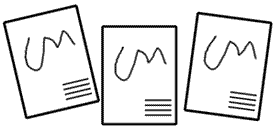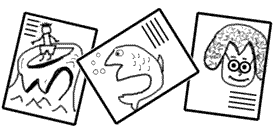Objectives
- Students will create a group drawing.
- Students will learn about group dynamics by discussing the issues that arose in their groupsand how they resolved them.
Materials
- Drawing Paper (18 x 24 or larger)
- Crayons
Procedures
- Divide students into groups of four or five.
- With a black felt pen, draw an identical squiggle in the center of 4 (or 5 depending on the number of groups in the class) large sheets of drawing paper.
- In the lower right corner of each sheet, draw several lines on which students can write their names.
- Give each group one of these identical sheets of paper.

- Explain that each group will be turning the squiggle into a picture.
- Direct the groups to work in separate areas of the room so they can't overhear each other.
- Tell students to brainstorm ideas of what the squiggle might be turned into.
- Encourage students to turn the paper in each of the four directions to get ideas about what they might draw.
- As students brainstorm, visit each group to make sure everyone (even quiet group members) is sharing ideas.
- Instruct students to agree upon what the group will turn their squiggle into.
- When all groups have chosen their ideas, distribute one crayon to each student, giving each child in a group a different color.
- Tell students they may use only the crayon they were given. Each color will represent the work of a single child.
- Instruct the students to write their names on the paper using their color crayon.
- Give students time to add to the squiggle to complete the picture their group decided upon.
- The group decides what to draw where, and the actual drawing is done by the child whose crayon is the appropriate color. (It will be easy to see who does most of the drawing by the predominance of the child's color.)
- Encourage the groups to add final details and compose a good title for their drawing.
- Bring groups back together to share their drawings.
- Give each group enough time to comment on its drawing.
- Discuss the group process by asking the class the following questions:
- What can we tell from the colors of the drawings about sharing the task and whether everyone got a turn?
- Did anyone feel left out?
- Did someone in your group do something to help others?
- What difficulties arose? Did someone help smooth out the difficulty?
- What made the task harder?
- What made the task easier?
- Repeat this activity a week or so later with a different squiggle but without changing the rest of the format of the activity to give the children an opportunity to build on what they've learned about cooperation.

Excerpted from Elementary Perspectives by William J. Kreidler.





